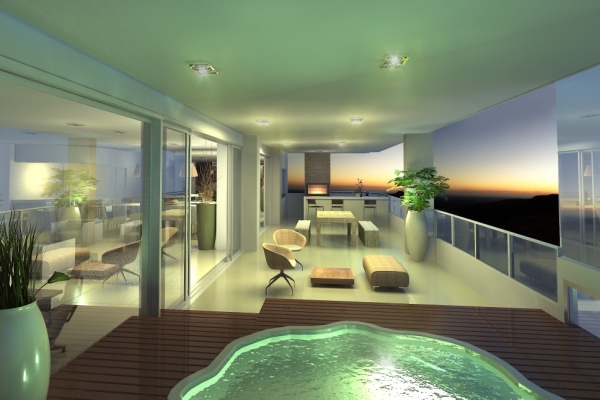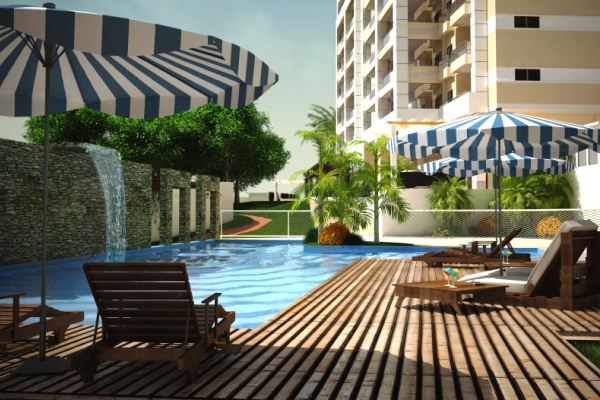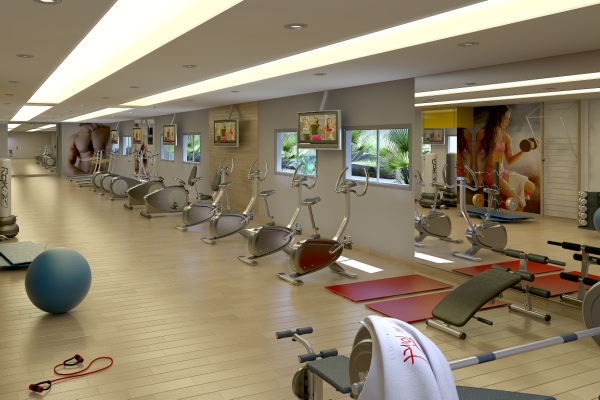Caixa Construções: Real Estate Market in Mato Grosso
Daniel Moreno, Director of Caixa Construções
Daniel Moreno comments on the real estate and construction sectors in Mato Grosso and presents Caixa Construções, its history, differentials and main projects. He also shares his vision for the future of the company and mentions the importance of sustainability in Caixa’s projects.
Interview with Daniel Moreno, Director of Caixa Construções
Can you tell us a bit about your company and what makes Caixa Construções different to others on the market?
We would like our buildings to become an example of excellence for buyers and users. We want our clients to be assured that if they purchase from Caixa Construções, the building will be well designed, will fulfil all requirements, will be a good investment and will be a benefit to the city itself as well as its inhabitants.
Caixa Construções began as a project between three friends, where each person saw in the other talents and qualities that they didn’t have themselves and so they all came together to complement each other.
I would describe the market in Cuiabá as quite chaotic; everyone does a bit of everything and there are many people offering services in this area. I have 30 years of professional experience in São Paulo, in the construction and property development business. The large construction companies are also development businesses, which is quite different.
As a new company trying to set up and compete on this chaotic market in Cuiabá, a new company needs to show strength and reliability. This is difficult when there is no way of showing off your CV! So we realised that we needed to find out where there was a niche that needed to be filled, and we would then specialise in these areas that had no competition. We had to differentiate ourselves from the competition.
Where we differentiate ourselves is principally in our architectural concepts and the nature of our projects. In contrast with other companies, we work with our team of architects, in fact my wife is an architect. Some people think architecture is simple and comes on its own, but that is only when the concept is well thought out and used to the maximum advantage.
The great differential that Caixa offers today is product concept. Let’s imagine that there are X amount of products on the market, all competing with each other. Here in Cuiabá we have about 4 companies all competing with each other, offering more or less the same products in pretty much the same places. In this sense we broke away from this and we began to bring out products that broke the mould in places that had never been considered before.
Forest Hill today is our most emblematic project in this sense. These are the largest apartments on the market in Cuiabá at the moment; they are 240 m2 and are on the outskirts of the city. It would never have been thought of to build apartments like these in this area, the two main areas are normally Goiabeiras or Santa Rosa. Most people would only ever think to build such apartments in these two neighbourhoods. However, we chose to build on the outskirts of Cuiabá and we sold more than 60% of the apartments without any publicity.

This brings me to another point; we don’t do any direct publicity for any of our apartments. We only have indirect publicity through the website, media reports, or via our brand strengthening initiatives. We never directly advertise the product itself.
So Forest Hill for me is a symbol of what Mato Grosso represents in Brazil. Mato Grosso is a country within a country. It is nearly 1 million km2; more than a third of all Brazil’s exports pass through here. More than 70% of the population of Mato Grosso are not originally from here. Cuiabá is one of the capital cities with the largest growth in the last 20 years. I think even the people here in Mato Grosso can’t begin to imagine the growth potential of this state. Things have been happening so quickly in Mato Grosso. The public sector can’t keep up in terms of infrastructure with the developments of the private sector. The biggest hindrance in Mato Grosso is the infrastructure. Production is happening so fast that the transport and other tertiary services can’t keep up with it.
We have noticed that all businessmen and even the statesmen have commented that the infrastructure is their greatest challenge here in Mato Grosso. Can you tell us about the property market here? Are you experiencing a property boom?
Yes, we really are experiencing a boom. We began our company 2 and a half years ago in a small house, in fact it was just two rooms in the Bosque de Saúde neighbourhood. I would say since then we have grown tenfold and we have been in our new offices for nearly 11 months now. I never imagined it would be like this, I had never seen anything like it and I was coming from São Paulo. Today we have projects that are worth over 300 million Brazilian Reals in potential sales value. I honestly don’t know of another case such as ours.
What type of projects do you have?

We have projects in the residential area, or of really high standard and design like Forest Hill, whose concept is to be like a vertical mansion. We have a client in this building who bought two apartments one above the other because he felt they weren’t big enough so wants to make two into one. This is Mato Grosso. This is how people here think! They are people that have come from other states in Brazil like Rio Grande do Sul, Santa Catarina, or Paraná having sold 500 hectares of land 20 or 30 years ago and bought 5 or 10 thousand hectares here in Mato Grosso, in areas where there were no roads or electricity. They were real pioneers; this was the ‘Promised Land’. Today these people are making 20 or 30 million Brazilian Reals a year. Nothing can stop them, they are always thinking of buying more land, more tractors, etc. These people are always thinking of how they can keep growing.
A consultant that works in the area of logistics told me that in Mato Grosso an area of 6 or 7 million hectares has the production potential of 10 million hectares without having to chop a single tree down. This means that Mato Grosso’s production in 5 years’ time is going to be 50% more than it is today. This brings in more people to work and more development. The railway that is proposed by the government in partnership with the Chinese government is an investment of 10 billion Brazilian Reals. Farmers are going to make US $200 per ton of extra soya for each ton of soya produced in Mato Grosso and this money is going to be fed back into the market here in Mato Grosso.
So this enormous development has a direct effect on construction both residential and commercial?
Yes, without a doubt. 2 years ago, Cuiabá did not have a market for launching new businesses, there was nowhere to rent or buy a shop or commercial site. 2 years ago was when we began to see commercial buildings. So we did some research into what was being sold, how and where. We found that nearly all the buildings were totally saturated and most had little possibility of installing elevators. I don’t mean to speak badly about them but I must be honest. These builders are only thinking of their profits, by cutting costs. They put in 3 elevators when the building really needs 6. The halls are 12 m2 when they should be 50 m2 to have enough room to comfortably move about in. They only think of the money, but people buy this illusion innocently. The buyers don’t have the qualifications to understand the technical side of deciding spatially what a building requires to suit the needs of its users.

This concept of making a place suitable to the influx of people using it is what we have implemented in The Point: two buildings each with 9 floors and 3 elevators, and 370 parking spaces. The building and parking will be divided by quota. The future client will be able to park their car 10 metres from the elevator, allowing him to get to the room he needs to be in within three minutes, without any commotion or unnecessary waiting. It is all part of designing the building effectively.
We also will have a mall on the ground floor with 7 shops, all rented out. There will be a gym, a computer store and support centre, a bank, a gift store, a deli with a bakery and restaurant, a pharmacy, etc. – everything that the people who work here on a daily basis might need. People here won’t have to take their car out of the garage to go and get anything. Everything can be done within the building. We are focused on helping people save time by providing these services.
What are the main projects that you are working on right now?
Our main project is really promoting this concept of being able to live, work and play in the same building. Our aim is to save people’s time and reduce their need to travel. This is our commercial project.
We are also working on two other much larger projects, perhaps the largest property projects in the region. We have 400,000 m2 already built over 7 or 8 years. We are in the phase of market research nationally and internationally. Projects like this are happening in São Paulo and Recife; we call them cities within cities.
We are seeing this all over the world, particularly in the Middle East and Dubai.
It is due to the fact that the public sector can’t keep up with the demands of the population. In a city within a city you can have everything you need including security in a controlled area.
What are your goals for the next two years?
We would like our buildings to become an example of excellence for buyers and users. In terms of value, we want our customers to feel that our properties are worth the money that they paid, and that these buildings will be viable and good investments for the future. We want our clients to be assured that if they purchase from Caixa Construções, the building will be well designed, will fulfil all requirements, will be a good investment and will be a benefit to the city itself as well as its inhabitants.
Can you tell us a bit about sustainability? Mato Grosso is a very hot region, does this affect design?
All the technical side is of great importance to us. Temperatures in Cuiabá can reach up to 50°C; normally we have temperatures of around 45°C. So we have to use special materials that insolate up to 3 times more than materials used by other construction companies. This obviously increases our costs a little but it doesn’t increase the cost for the customer. We believe that when people move into our buildings they notice the difference when the sun hits the building in the afternoon. The temperature does not rise like it does in other buildings. It is a very important detail in all our projects. It also means people don’t have to use so much energy in air conditioning, so it is better for the environment.
Our goal is not only to be totally sustainable and to have all the certifications necessary but also to reduce by at least 10 to 12% the city’s climate change via solar energy, and the increase in wind speed and relative humidity. We are thinking about areas where people normally park their cars in open spaces, for example here in the Shopping Pantanal. We have proposed building a small lake of 20,000 m2 with 2 levels of car parking below. We can build a park all around this lake area above the car park. The area will be pedestrian only, and all the energy will come from solar voltaic panels.
Apart from this, we try and have managed to maximise use of space in all our projects. All our rooms are integrated, we don’t use many corridors. This is really important; when you buy an apartment of 250 m2 the normal amount of space lost to corridors is about 12 to 14% of the apartment, we are trying to reduce this to fewer than 5%. We go back to the drawing board every time a proposal is put forward until we reach 5% corridor space. There are many other areas that we are trying to improve but that shall have to be discussed in another interview!